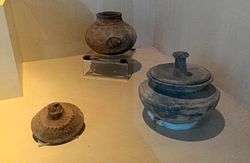Buni culture
Buni culture is a prehistoric clay pottery culture that flourished in coastal northern West Java, Jakarta and Banten around 400 BC to 100 AD [1] and probably survived until 500 AD. The culture was named after its first discovered archaeological site, Buni village in Babelan, Bekasi, east of Jakarta.
Buni culture is known for its peculiar pottery with incised, geometrical decorations, and the fact that it yielded the first Indian rouletted wares recorded from Southeast Asia.[2] Clay potteries were later developed with evidence found in Anyer to Cirebon. Artifacts such as food and drink containers, dated from 400 BC to AD 100 have been found, mostly as burial gifts.[1]
Buni clay pottery culture bears similarities with Sa Huỳnh culture in Vietnam. Pottery artefacts were discovered such as clay dishes, pots, water jars and other daily utensils. Megalithic culture can also be found, such as beads as burial gifts, and also menhir and stone table. The people that supported Buni culture had established trade with foreign people, and the kingdom of Tarumanagara is probably the successor of Buni culture after the adoption of Hinduism. The remnants of Buni pottery have also been discovered at the Batujaya Archaeological Site and the Kendaljaya site in Karawang.
Artifacts
 lncised pot containers
lncised pot containers Containers with lids
Containers with lids Jars
Jars
References
- Manguin, Pierre-Yves and Agustijanto Indrajaya, "The Archaeology of Batujaya (West Java, Indonesia):an Interim Report", in Uncovering Southeast Asia's past: selected papers from the 10th International Conference of the European Association of Southeast Asian Archaeologists (Elisabeth A. Bacus, Ian Glover, Vincent C. Pigott eds.), 2006, NUS Press, ISBN 9971-69-351-8
- Miksic, John N., The Buni Culture, In: Southeast Asia, from prehistory tons history (Ian Glover dan Peter Bellwood eds.), London 2004, ISBN 0-415-29777-X
- Simanjuntak, Truman, M. Hisyam, Bagyo Prasetyo, Titi Surti Nastiti, Archaeology: Indonesian perspective : R.P. Soejono's festschrift, LIPI, 2006, ISBN 979-26-2499-6
Notes
- 1 2 Zahorka, Herwig (2007). The Sunda Kingdoms of West Java, From Tarumanagara to Pakuan Pajajaran with Royal Center of Bogor, Over 1000 Years of Propsperity and Glory. Yayasan cipta Loka Caraka.
- ↑ Manguin, Pierre-Yves and Agustijanto Indrajaya. The Archaeology of Batujaya (West Java, Indonesia):an Interim Report, in Uncovering Southeast Asia's past.
External links
- Uncovering Southeast Asia's past
- Situs Buni Terabaikan. Kompas daring. Edisi 30 May 2007.


